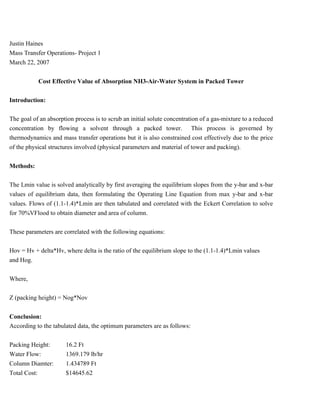Justin Haines Separations Project
- 1. Justin Haines Mass Transfer Operations- Project 1 March 22, 2007 Cost Effective Value of Absorption NH3-Air-Water System in Packed Tower Introduction: The goal of an absorption process is to scrub an initial solute concentration of a gas-mixture to a reduced concentration by flowing a solvent through a packed tower. This process is governed by thermodynamics and mass transfer operations but it is also constrained cost effectively due to the price of the physical structures involved (physical parameters and material of tower and packing). Methods: The Lmin value is solved analytically by first averaging the equilibrium slopes from the y-bar and x-bar values of equilibrium data, then formulating the Operating Line Equation from max y-bar and x-bar values. Flows of (1.1-1.4)*Lmin are then tabulated and correlated with the Eckert Correlation to solve for 70%VFlood to obtain diameter and area of column. These parameters are correlated with the following equations: Hov = Hv + delta*Hv, where delta is the ratio of the equilibrium slope to the (1.1-1.4)*Lmin values and Hog. Where, Z (packing height) = Nog*Nov Conclusion: According to the tabulated data, the optimum parameters are as follows: Packing Height: 16.2 Ft Water Flow: 1369.179 lb/hr Column Diamter: 1.434789 Ft Total Cost: $14645.62
- 2. At any water flow higher than 1369.179 lb/hr, the cost of water became more costly than the cost of packing height. Therefore total costs would increase after any water flow above this value. Gas Flow Rate at Bottom of Tower: 1420 lb/hr NH3 Removed from Air: 2.2 lb mol/hr or 37.4 lb/hr Total liquid Flow (includes NH3 absorbed) rate at bottom: 1397.7 lb/hr Preliminary Calculations to Solve for Lmin:
- 3. Sample Calculation at 1.1*Lmin
- 5. Height, 70%V Total Cost ft Lnew lb/hr Lm lb/hr*ft^2 Col.Dia ft lb/s*ft^2 $ X*Lmin 46.6 1084.2 695.8 1.41 0.253 17315.8 1.1 39 1133.48315 709.9807372 1.425737 0.246790091 17215.9507 1.15 29.2 1182.76503 740.8494649 1.425737 0.246790091 15759.1 1.2 23.9 1232.0469 771.7181926 1.425737 0.246790091 15096.002 1.25 17.9 1330.61066 822.9715118 1.434789 0.24368569 14722.9124 1.35 16.2 1369.1797 841.2597 1.434789 0.24368569 14645.62 1.38 <--Most Cost Effective 15.8 1379.8925 853.45 1.434789 0.24368569 14720 1.4 14.7 1409.4616 871.7401 1.434789 0.24368569 14763.25 1.43 14.2 1429.1744 883.932 1.434789 0.24368569 14815.92 1.45 Total Cost Vs Lm 17500 17000 Total Cost, USD 16500 16000 Series1 15500 15000 14500 690 740 790 840 890 Lm lb/hr*ft^2




